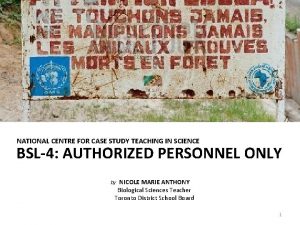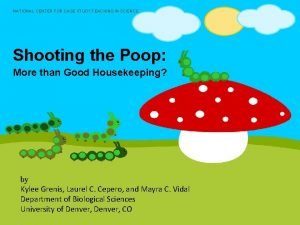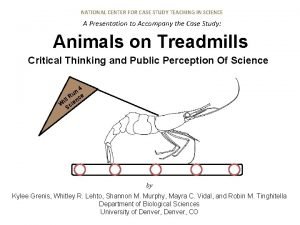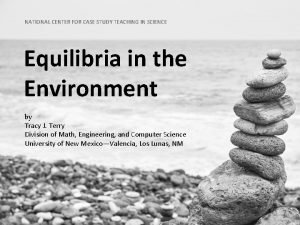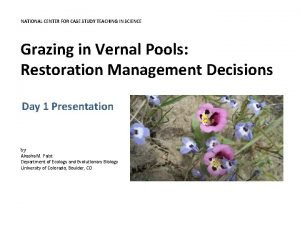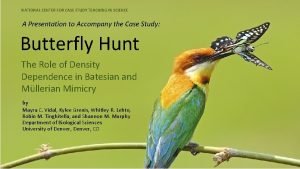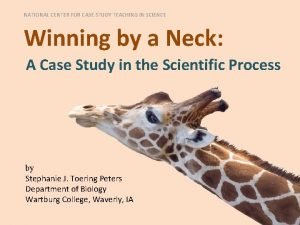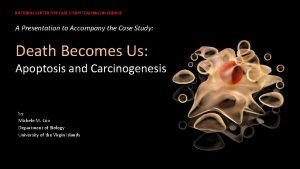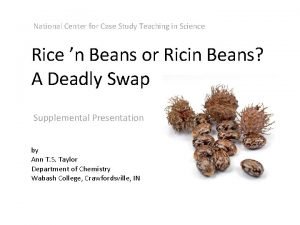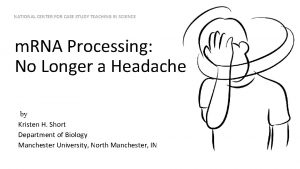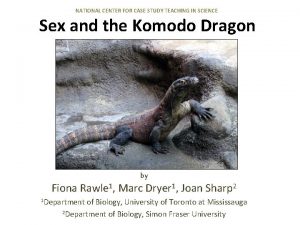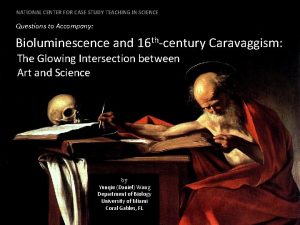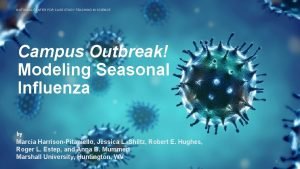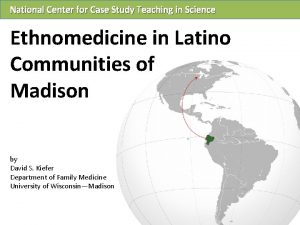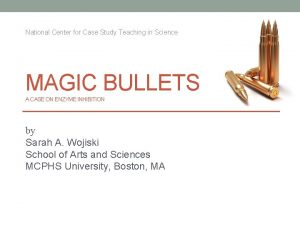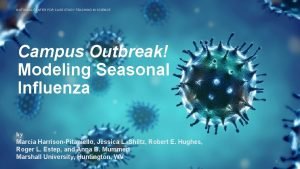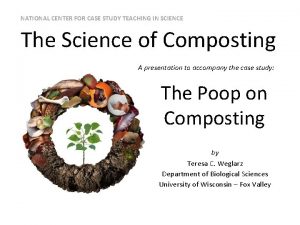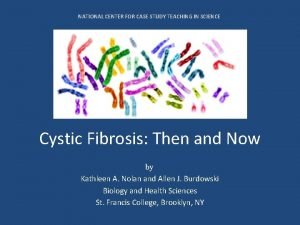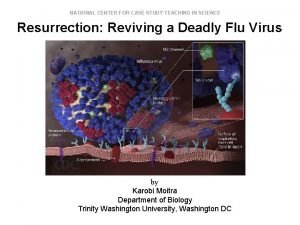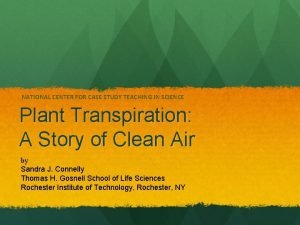NATIONAL CENTER FOR CASE STUDY TEACHING IN SCIENCE






















- Slides: 22

NATIONAL CENTER FOR CASE STUDY TEACHING IN SCIENCE MRSA in the NICU: Outbreak or Coincidence? by Maria P. Chadiarakou, Anitha Sundararajan, Ingrid E. Lindquist, Gabriella A. De. Francesca, Madeline Kwicklis, Drew A. Lighthall, Natasha E. Farmer, Michèle I. Shuster, and Joann Mudge

What is MRSA? v MRSA stands for “methicillin-resistant Staphylococcus aureus” v Staphylococcus aureus is a species of bacteria that can infect humans. v MRSA refers to strains of Staphylococcus aureus that carry resistance to the antibiotic, methicillin. v It could also have additional resistance genes in the same strain. v Because of the antibiotic resistance(s), these strains can be very difficult to treat. v Symptoms of Staphylococcus aureus infections can vary based on circumstances such as a person’s health, where on the body the infection is located, and the strain of the bacterium. v Bacteria that belong to the same strain have the same or similar sets of genes that make them behave the same way. A bacterial species can have several different strains. v A Staphylococcus aureus infection can range from no symptoms to skin infections such as boils to serious respiratory infections and even potentially fatal bloodstream 2

MRSA in the NICU v Why do we care if MRSA is in the NICU? v NICU stands for Neonatal Intensive Care Unit. v The NICU is a hospital unit that specializes in intensive treatments required for babies who are very sick, were born premature, or have other medical issues. v Immune systems are not fully developed in these babies. v Why is it important to know if it is an outbreak or coincidence? v Outbreak: a sudden increase in the number of disease cases, implying that the cases are related. v Coincidence: by chance, we have more cases of the disease than normal but they are not related. 3

One day in the NICU… v On Wednesday morning, Dr. Tashya Smith is the attending doctor at the NICU. v Nurse David Johnson is also assigned to the NICU. v You are a nurse in training working with Nurse Johnson to learn and practice medical procedures. All of you have tested negative in your last Staphylococcus aureus test and are diligent about washing your hands. 4

Later that day… v Dr. Smith orders a MRSA test for a new patient (Patient 1). v You and Nurse Johnson take a nasal swab and send it to the lab. v To do a nasal swab, you rub a stick with absorbent material on the end (like a large version of a Q-tip) around the inside of the patient’s nose. v The test comes back positive for MRSA. 5

Antibiogram v You and Nurse Johnson look over the antibiogram. v The antibiogram shows which antibiotics can be used to treat the Staphylococcus aureus infection and which won’t work because the bacterial strain has become resistant to them. Tetracycline Trimethoprim Rifampin Fusidic acid Mupirocin Linezolid R S Kanamycin S Gentamicin S Ciprofloxacin S Clindamycin S Erythromycin R R R R Cefoxitin Antibiotics Tobramycin Patient 1’s antibiogram R = resistant S = susceptible v In addition to methicillin, what other antibiotics is the Staphylococcus aureus strain from Patient 1 resistant to? 6

After a couple of months… (77 days since Patient 1 admitted) v Patient 1 develops a high fever. Dr. Smith orders a test for MRSA in the blood (bacteremia). v You do the blood draw while Nurse Johnson supervises. v The lab analyzes the blood and it is positive for MRSA. v The MRSA strain has the same antibiogram as the original isolate from Patient 1. Tetracycline Trimethoprim Rifampin Fusidic acid Mupirocin Linezolid R S Kanamycin S Gentamicin S Ciprofloxacin S Clindamycin S Erythromycin R R R R Cefoxitin Antibiotics Tobramycin Patient 1’s antibiogram R = resistant S = susceptible 7

Two days later… v Because of the presence of MRSA bacteremia in the NICU, the hospital’s infection-control office brings in a team to investigate. v v The head of the Infection Control Office, Taylor Norton (Masters of Public Health), wants someone from the NICU on the team and you volunteer. You help implement some immediate precautionary measures to avoid further spread of MRSA. v Remind staff to wash hands and wear gloves and aprons. v Perform random checks to make sure the staff is following these rules. v Minimize movement of staff, infants and equipment between rooms. v Implement deep cleaning procedures. v Inform parents and ask them to follow the procedures. 8

Infection Control v Questions the Infection Control Office wants answered: v Could a MRSA strain be spreading in the NICU? v Could we have an outbreak of this strain? v Could there be two different strains that have the same antibiogram? v Has it spread beyond the NICU? v How are you going to answer these questions? v You send all the Staphylococcus aureus samples you collected to the lab for antibiogram typing and DNA sequencing. 9

Who has MRSA? v You and other staff members that have had contact with the NICU are tested for MRSA. v Three staff members are positive for MRSA. v v v Because the antibiogram is different from that of Patient 1, you conclude that they picked it up elsewhere and they are not part of the NICU outbreak. You help test all NICU patients for MRSA and repeat tests weekly. v Most had been tested for MRSA when they were admitted to the NICU and were negative. v Several now test positive for MRSA. v Several more test positive for MRSA over the next week or so. v Eventually all NICU patients test positive. You isolate Staphylococcus aureus strains from each of the NICU patients and from patients in other regions of the hospital. 10

MRSA Sampling Timeline NICU Patient 15 Non-NICU Patient 19 bacteremia NICU Patient 1 bacteremia NICU Patient 6 and 8 Investigation starts NICU Patient 10 NICU closed NICU Patient 7 and 11 Patient Timing in Hospital (all patients except 19 and 20 were in the NICU) 15 1 6 7 11 19 Non-NICU Patient 20 bacteremia NICU Patient 12 8 10 12 20 MRSA bacteremia is when MRSA gets into the bloodstream. Only sequence type 22 are shown.

Phenotypic Results v Ten strains are sequence type 22. v Same “family” of MRSA. v How many have the same antibiogram as Patient 1? Patient 1 B* 6 C* 7 C* 8 C* 10 C* 11 C* 12 C* 15 C* 19 B 20 B * NICU Antibiogram RRRRRRRSSSSRS RRRRRRRSSSSRS RRRRSSSSSSSSS RRRRSSSSS 7

Genetic Analysis v Whole genome sequencing of the sequence type 22 strains. v Whole genome sequencing allows us to use the sequence of the entire bacterial genome to determine the relationships between them. v It is also possible to estimate how the bacteria are related by sequencing the same genomic region in each bacteria. 13

Genetic Analysis v We lined up the sequences and identified regions of the genome where the bacterial samples differed (SNPs). v Used these regions to build a phylogenetic tree v Based on number of differences v Determine relationships v Build a tree v How does this compare to using phenotypic data to build a tree? 14

You tell me…. v You have two data sets: v DNA sequence (genotype) data v Genotype = an organisms’s genes or DNA sequences v Antibiogram (phenotype) data v Phenotype = an organism’s characteristics (in this case, resistance to antibiotics) v Each dataset has all 10 sequence type 22 strains plus one unrelated strain, called an outgroup, for comparison and to help the tree building program orient the tree correctly. v The unrelated strain (14 C) 15

Your turn v Use online programs to analyze each data set v Ultimately each data set will be used to build a tree. v Predicted relationships between the strains. v Instructions on handout v Once you have each tree, take a screenshot or draw a quick sketch. v Work with your neighbors to answer the questions at the end of the handout. 16

What do your trees look like? 17

Antibiogram tree (phenotype)

DNA tree (genotype)

Both trees (zooming in on sequence type 22) Antibiogram DNA

Which strains are part of the NICU-Outbreak? Antibiogram DNA

Which tree provides more information? Antibiogram DNA
 National centre for case study teaching in science
National centre for case study teaching in science National center for case study teaching in science
National center for case study teaching in science National center for case study teaching in science
National center for case study teaching in science National center for case study teaching in science
National center for case study teaching in science National center for case study teaching in science
National center for case study teaching in science National center for case study teaching in science
National center for case study teaching in science National center for case study teaching in science
National center for case study teaching in science Best worst and average case
Best worst and average case Fbi virtual case file case study
Fbi virtual case file case study My favorite subject is music
My favorite subject is music Definition of microteaching
Definition of microteaching Kontinuitetshantering
Kontinuitetshantering Typiska novell drag
Typiska novell drag Tack för att ni lyssnade bild
Tack för att ni lyssnade bild Vad står k.r.å.k.a.n för
Vad står k.r.å.k.a.n för Shingelfrisyren
Shingelfrisyren En lathund för arbete med kontinuitetshantering
En lathund för arbete med kontinuitetshantering Särskild löneskatt för pensionskostnader
Särskild löneskatt för pensionskostnader Vilotidsbok
Vilotidsbok Sura för anatom
Sura för anatom Densitet vatten
Densitet vatten Datorkunskap för nybörjare
Datorkunskap för nybörjare Stig kerman
Stig kerman
